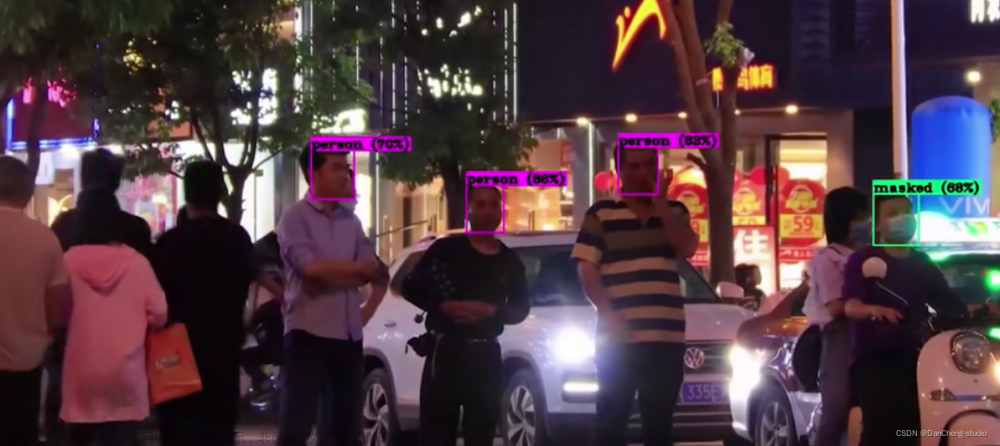前言
随着人工智能的不断发展,深度学习这门技术也越来越重要,很多人都开启了学习机器学习,本文将通过项目开发实例,带领大家从零开始设计实现一款基于深度学习的图像识别算法。
学习本章内容, 你需要掌握以下基础知识:
- Python 基础语法
- 计算机视觉库(OpenCV)
- 深度学习框架(TensorFlow)
- 卷积神经网络(CNN)
一、基础知识介绍
-
Python
Python 是一个高层次的结合了解释性、编译性、互动性和面向对象的脚本语言。学习链接:Python学习 -
OpenCV
OpenCV 是一个开源的跨平台计算机视觉库。实现了图像处理和计算机视觉 方面的很多通用算法。在本设计中它主要集中在图像的采集以及图像预处理等功能。学习链接:OpenCV学习 -
TensorFlow
TensorFlow 是谷歌开源的计算框架,TensorFlow 框架可以很好地支持深度学 习的各种算法。本课设图像识别部分采用的深度学习(deep learning)算法就是 用 TensorFlow 框架实现的。学习链接:TensorFlow学习 -
CNN
卷积神经网络(Convolutional Neural Networks, CNN)是一类包含卷积计算 且具有深度结构的前馈神经网络(Feedforward Neural Networks),是深度学习(deep learning)的代表算法之一。学习链接:CNN学习
二、数据集收集
在进行图像识别前,首先需要收集数据集(数据集下载),其次对于数据集做预处理,然后才能通过深度卷积神经网络来进行特征学习,得到估计分类模型。对于数据集的要求,在卷积神经网络(CNN)中,由于对输入图像向量的权值参数的数量是固定的,所以在用卷积网络(CNN)对数据集进行模型训练前需要进行图像预处理,保证输入的图像尺寸是固定一致的。
本案例以实现垃圾识别分类作为最终实现目标, 收集数据集包含四类图片,分别为厨余垃圾、可回收垃圾、有毒垃圾、其它垃圾,每类图片数据集规模为200张(学习者可以根据自己需求选择数据集类型及规模。数据集下载

数据集图片预处理代码如下:
#数据图片rename
#数据集路径:(self.image_path = "./picture/")
def rename(self):
listdir = os.listdir(self.image_path)
i = 0
while i < len(listdir):
images_list_dir = os.listdir(os.path.join(self.image_path, listdir[i]))
j = 0
while j < len(images_list_dir):
old_name = os.path.join(self.image_path, listdir[i], images_list_dir[j])
new_name = os.path.join(self.image_path, "%d-%d" % (i, j) + ".jpg")
os.rename(old_name, new_name)
j += 1
i += 1
for p in range(len(listdir)):
tmp_path = os.path.join(self.image_path, listdir[p])
if os.path.exists(tmp_path):
os.removedirs(tmp_path)
#图片resize
def resize_img(self):
listdir = os.listdir(self.image_path)
for file in listdir:
file_path = os.path.join(self.image_path, file)
try:
imread = cv2.imread(file_path)
resize = cv2.resize(imread, (200, 200))
cv2.imwrite(os.path.join(self.image_path, file), resize)
except Exception:
os.remove(file_path)
continue

#转存图片信息到csv文件
#csv生成路径:(csv_file_saved_path = "./picture/")
def train_data_to_csv(self):
files = os.listdir(self.image_path)
data = []
for file in files:
data.append({"path": self.image_path + file, "label": file[0]})
frame = pd.DataFrame(data, columns=['path', 'label'])
dummies = pd.get_dummies(frame['label'], 'label')
concat = pd.concat([frame, dummies], 1)
concat.to_csv(csv_file_saved_path + "train.csv")

三、模型训练
模型训练代码如下:
#模型训练算法
def build_model():
with tf.name_scope("input"):
x = tf.placeholder(tf.float32, [None, 200, 200, 3], "x")
y = tf.placeholder(tf.float32, [None, 5], "y")
with tf.variable_scope("conv_layer_1"):
conv1 = tf.layers.conv2d(x, 64, [3, 3], activation=tf.nn.relu, name='conv1')
max1 = tf.layers.max_pooling2d(conv1, [2, 2], [2, 2])
bn1 = tf.layers.batch_normalization(max1, name='bn1')
output1 = tf.layers.dropout(bn1, name='droput')
with tf.variable_scope("conv_layer_2"):
conv2 = tf.layers.conv2d(output1, 64, [3, 3], activation=tf.nn.relu, name='conv2')
max2 = tf.layers.max_pooling2d(conv2, [2, 2], [2, 2], name='max2')
bn2 = tf.layers.batch_normalization(max2)
output2 = tf.layers.dropout(bn2, name='dropout')
with tf.variable_scope("conv_layer_3"):
conv3 = tf.layers.conv2d(output2, 64, [3, 3], activation=tf.nn.relu, name='conv3')
max3 = tf.layers.max_pooling2d(conv3, [2, 2], [2, 2], name='max3')
bn3 = tf.layers.batch_normalization(max3, name='bn3')
output3 = bn3
with tf.variable_scope("conv_layer_4"):
conv4 = tf.layers.conv2d(output3, 32, [3, 3], activation=tf.nn.relu, name='conv4')
max4 = tf.layers.max_pooling2d(conv4, [2, 2], [2, 2], name='max4')
bn4 = tf.layers.batch_normalization(max4, name='bn4')
output = bn4
flatten = tf.layers.flatten(output, 'flatten')
with tf.variable_scope("fc_layer1"):
fc1 = tf.layers.dense(flatten, 256, activation=tf.nn.relu)
fc_bn1 = tf.layers.batch_normalization(fc1, name='bn1')
dropout1 = tf.layers.dropout(fc_bn1, 0.5)
with tf.variable_scope("fc_layer2"):
fc2 = tf.layers.dense(dropout1, 128, activation=tf.nn.relu)
dropout2 = tf.layers.dropout(fc2)
with tf.variable_scope("fc_layer3"):
fc3 = tf.layers.dense(dropout2, 64)
dropout3 = tf.layers.dropout(fc3)
with tf.variable_scope("fc_layer4"):
fc4 = tf.layers.dense(dropout3, 32)
with tf.variable_scope("fc_layer5"):
fc5 = tf.layers.dense(fc4, 5)
softmax = tf.nn.softmax(fc5, name='softmax')
predict = tf.argmax(softmax, axis=1)
loss = tf.reduce_sum(tf.nn.softmax_cross_entropy_with_logits_v2(logits=fc5, labels=y, name='loss'))
tf.summary.scalar("loss", loss)
accuracy = tf.reduce_mean(tf.cast(tf.equal(predict, tf.argmax(y, axis=1)), tf.float32))
tf.summary.scalar("acc", accuracy)
merged = tf.summary.merge_all()
return x, y, predict, loss, accuracy, merged, softmax

#模型训练
def train(self):
saver = tf.train.Saver(max_to_keep=3)
sess = tf.InteractiveSession(config=self.config)
sess.run(tf.global_variables_initializer())
writer = tf.summary.FileWriter("./log", graph=sess.graph)
for i in range(100):
j = 1
all_loss_ = 0
all_acc_ = 0
while j <= self.batches and self.has_next_batch:
train_x, train_y = self.next_batch()
_, loss_, accuracy_, merged_ = sess.run([ self.opt, self.loss, self.accuracy, self.merged ],
feed_dict={self.x: train_x, self.y: train_y})
all_loss_ += loss_
all_acc_ += accuracy_
print("\repoch %d-- batch: %d--> " % (i, j) + "=" * j + ">" + "-" * (
self.batches - j) + "\t\t loss: %.4f, acc: %.4f" % (
loss_, accuracy_), )
j += 1
writer.add_summary(merged_, i * self.batches + j - 1)
print("\n===epoch %d=== > mean loss is : %.4f, mean acc is : %.4f" % (
i, all_loss_ / self.batches, all_acc_ / self.batches))
test_x, test_y = self.get_test_data()
test_loss_, test_acc_ = sess.run([ self.loss, self.accuracy ],
feed_dict={self.x: test_x[ 0:16 ], self.y: test_y[ 0:16 ]})
print("===epoch %d=== > test loss is : %.4f, test acc is : %.4f" % (
i, test_loss_, test_acc_))
self.start = 0
self.has_next_batch = True
if i % 5 == 0:
saver.save(sess, "./h5_dell/mode.ckpt", i)
sess.close()

四、图像识别分类
图像识别分类代码:
#利用模型实时识别图像
def predict_value(self, type='image', image_path=None):
saver = tf.train.Saver()
sess = tf.InteractiveSession()
saver.restore(sess, tf.train.latest_checkpoint("./h5_dell1/"))
if type == 'image':
assert image_path is not None
image = cv2.imread(image_path)
image = cv2.resize(image, (200, 200))
image = np.asarray(image, np.float32) / 255.
image = np.reshape(image, (1, image.shape[ 0 ], image.shape[ 1 ], image.shape[ 2 ]))
[ predict, probab ] = sess.run([ self.predict, self.probab ], feed_dict={self.x: image})
# predict = sess.run(self.predict, feed_dict={self.x: image})
# print("what? 1:",np.max(probab))
# print("what? 2:",predict[0])
return predict[0]
if (np.max(probab)<1):
print("recognise fail")
predict=4
print(predict)
elif type == 'video':
capture = cv2.VideoCapture(0)
while True:
ret, frame = capture.read()
resize = cv2.resize(frame, (200, 200))
x_ = np.asarray(resize, np.float32) / 255.
x_ = np.reshape(x_, [ 1, x_.shape[ 0 ], x_.shape[ 1 ], x_.shape[ 2 ] ])
[ predict, probab ] = sess.run([ self.predict, self.probab ], feed_dict={self.x: x_})
if predict == 0:
cv2.putText(frame, "0 probab: %.3f" % np.max(probab), (10, 50), cv2.FONT_HERSHEY_SIMPLEX, 2,
(0, 0, 255), 2, cv2.LINE_AA)
elif predict == 1:
cv2.putText(frame, "1 probab: %.3f" % np.max(probab), (10, 50), cv2.FONT_HERSHEY_SIMPLEX, 2,
(0, 255, 255), 2, cv2.LINE_AA)
elif predict == 2:
cv2.putText(frame, "2 probab: %.3f" % np.max(probab), (10, 50), cv2.FONT_HERSHEY_SIMPLEX, 2,
(0, 255, 0), 2, cv2.LINE_AA)
elif predict == 3:
cv2.putText(frame, "3 probab: %.3f" % np.max(probab), (10, 50), cv2.FONT_HERSHEY_SIMPLEX, 2,
(255, 0, 255), 2, cv2.LINE_AA)
elif predict == 4:
cv2.putText(frame, "4 probab: %.3f" % np.max(probab), (10, 50), cv2.FONT_HERSHEY_SIMPLEX, 2,
(255, 0, 255), 2, cv2.LINE_AA)
if predict==3:
print("1111")
print(predict)
cv2.imshow("recognized", frame)
key = cv2.waitKey(1)
if key == 27:
break
cv2.destroyAllWindows()
capture.release()

 文章来源:https://www.toymoban.com/news/detail-779300.html
文章来源:https://www.toymoban.com/news/detail-779300.html
总结
本章节内容以实际项目案例介绍神经网络图像识别算法的搭建及使用详细步骤,介 绍卷积神经网络实现图像识别分类的详细过程,以及实现效果的展示,希望文章能够帮助到大家,有问题请点击【链接】沟通交流, 获取源码。文章来源地址https://www.toymoban.com/news/detail-779300.html
到了这里,关于项目实战解析:基于深度学习搭建卷积神经网络模型算法,实现图像识别分类的文章就介绍完了。如果您还想了解更多内容,请在右上角搜索TOY模板网以前的文章或继续浏览下面的相关文章,希望大家以后多多支持TOY模板网!














